

Caine's Arcade. Encyclopedia on Early Childhood Development. Building children's writing skills through learning through play. A creative playground is only half a creative space; it’s also a creative attitude.
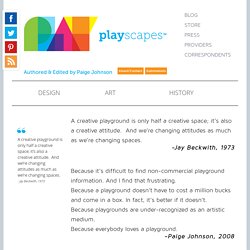
And we’re changing attitudes as much as we’re changing spaces. -Jay Beckwith, 1973. Susan Solomon and the Science of Play - Playscapes. Koch Landscape Architecture.
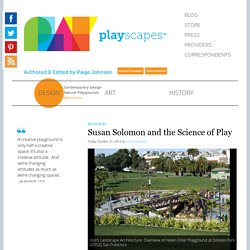
Overivew of Helen Diller Playground at Dolores Park (2012), San Francisco I‘m so pleased to welcome Susan Solomon to Playscapes! Susan is the author of American Playgrounds: Revitalizing Community Space. Teaching Young Children: Silent Play with Open-ended Materials. Cultivating Creativity in Young Children. IPA Declaration of the Child’s Right to Play. IPA Declaration of the Child’s Right to Play Tags : Child's Right to Play Declaration The IPA Declaration of the Child’s Right to Play was produced in November 1977 at the IPA Malta Consultation held in preparation for the International Year of the Child (1979).
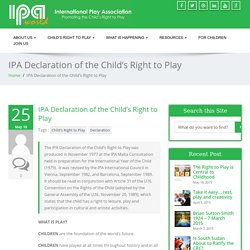
It was revised by the IPA International Council in Vienna, September 1982, and Barcelona, September 1989. It should be read in conjunction with Article 31 of the U.N. Convention on the Rights of the Child (adopted by the General Assembly of the U.N., November 20, 1989), which states that the child has a right to leisure, play and participation in cultural and artistic activities. CHILDREN are the foundation of the world’s future. The decline of play. The decline of play. Inside the world’s best kindergarten. At Fuji Kindergarten outside Tokyo, kids make the most of a magical environment designed just for them.

The roof of their oval-shaped school, designed by Tokyo-based firm Tezuka Architects, is an endless playground, and trees grow right through classrooms. So how do you build to let children be children? Says Takaharu Tezuka (TED Talk: The best kindergarten you’ve ever seen): Think like a kid. He was inspired by his own daughter and son, now twelve and nine, who he says “have become a part of his body.” As they grew up, their habits and desires became his, and in designing his school with his wife, Yui, he only needed to channel them to know what to build. The playground lets kids run forever “We designed the school as a circle, with a kind of endless circulation. Kids can slide to class “We put in a small mound of dirt at the bottom of the stairs leading from the roof — this was a trick to make the stairs shorter. Safety drills are super cute Being a non-human animal is encouraged. The Magic of Everyday Moments. How do you help parents and students of child development understand how they can best help young children thrive?
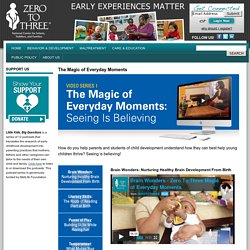
Seeing is believing! <<< Click the video titles to the left to view the first 4 videos in this compelling series. This video series has been made possible through the generous support of the MetLife Foundation Get More from the Magic of Everyday Moments! The complete set of the Magic of Everyday Moments: Seeing Is Believing (Series 1) videos on DVD or digital download with BONUS items for easy use in your daily practice: A User’s Guide with questions to spark discussion about the concepts presented in the videos and to encourage parents to apply the information to their own child(ren) and family. Benefits of play. The Science - National Institute for Play. Science and Human Play The NIFP is following what nature wants us to know about play.
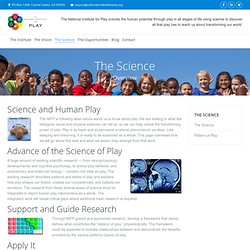
We are looking to what the biological, social and physical sciences can tell us, so we can help unlock the transforming power of play. Play is as basic and as pervasive a natural phenomenon as sleep. ICCP Links. Www.iccp-play.org/documents/news/ICCPseveralperspectives.pdf. Study Finds That Kindergarten is Too Easy - Inside School Research. Kindergarten might be the new 1st grade but it is still too easy.
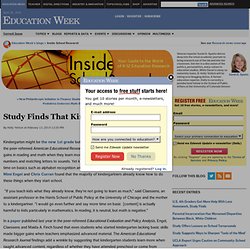
A forthcoming study in the peer-refereed American Educational Research Journal finds that students make bigger gains in reading and math when they learn more advanced content such as adding numbers and matching letters to sounds. Yet kindergarten teachers spend nearly twice as much time on basics such as alphabet recognition and counting out loud. Study authors Amy Claessens, Mimi Engel and Chris Curran found that the majority of kindergartners already know how to do these things when they start school. "If you teach kids what they already know, they're not going to learn as much," said Claessens, an assistant professor in the Harris School of Public Policy at the University of Chicago and the mother to a kindergartner.
Reflections on Play: Join the Conversation. The early childhood field has a history of conflict over means and goals that periodically erupts into public debates about the role of play versus academics and construction versus instruction.
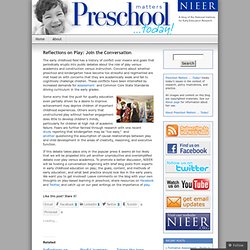
Concerns about whether preschool and kindergarten have become too stressful and regimented are met head on with concerns that they are academically weak and fail to cognitively challenge children. These conflicts have been intensified by increased demands for assessment and Common Core State Standards driving curriculum in the early grades. If this debate takes place only in the popular press it seems all too likely that we will be propelled into yet another unproductive and oversimplified debate over play versus academics. To promote a better discussion, NIEER will be hosting a conversation beginning with brief blog posts from experts in early childhood education on play; the goals, content, and methods of early education; and what best practice should look like in the early years.
Www.playwales.org.uk/login/uploaded/documents/INFORMATION SHEETS/play deprivation.pdf. Lack of Outdoor Play Said To Hurt Children’s Development. Play consulting - London Play. Play Resources. Www.unomaha.edu/schoolpsych/play resources/Web.resources.on.play.pdf. Muse.jhu.edu.proxy.libraries.uc.edu/journals/merrill-palmer_quarterly/v059/59.3.lindsey.pdf. Play Projects. Projects, Publications, and Presentations on Play in Early Childhood Ed.S.
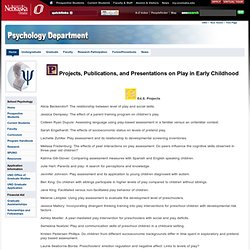
Projects. Play Resources. Buffettinstitute.nebraska.edu/research/early-childhood-education/learning-from-birth-age-8.aspx. Among the research facilities focusing on young children is the Ruth Staples Child Development Laboratory at the University of Nebraska-Lincoln.
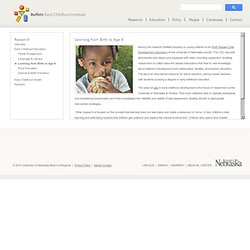
The CDL has both laboratories and classrooms equipped with video recording equipment, enabling researchers to collect data and assess interactions that lead to new knowledge about children’s development and relationships, families, and teacher education. The lab is an educational resource for future teachers, pairing master teachers with students pursuing a degree in early childhood education. The value of play in early childhood development is the focus of researchers at the University of Nebraska at Omaha. Www.ohchr.org/Documents/ProfessionalInterest/crc.pdf. C7 play and learning theorist - current frameworks. As Schools Cut Recess, Kids' Learning Will Suffer, Experts Say. When Deborah Gilboa's second-oldest son Nadav started coming home from first grade with discipline warnings from his teacher, Gilboa and her husband were perplexed. Nadav, who had just turned 6, had the same teacher in kindergarten and had rarely gotten into trouble.
So Gilboa, a family medicine doctor in Pittsburgh who consults at askdoctorg.com, and her husband sat down to ask their son what was going on. He had the answer right away. "He said, 'In kindergarten we had recess twice a day and we went to gym twice a week,'" Gilboa told LiveScience. Now, as a first-grader, Nadav's class only went to gym once every six days. "He said, 'I get this feeling in my legs when they want to run and that feeling moves up to my belly and when that feeling moves up to my head I can't remember what the rules are," Gilboa said. For kids like Nadav, the transition from summer freedom to the grindstone of the classroom may be tough.
Goodbye, playtime. Battling the Boys: Educators Grapple with Violent Play. In her 30 years as a kindergarten teacher in Illinois and Massachusetts, Jane Katch has watched graham crackers, a pretzel, celery, tree bark and fingers all become transformed into imaginary guns and other weapons. And she has learned to work with, rather than against, the violent boyhood fantasies that accompany these transformations. "When you try to ignore it, it doesn't go away. And when you try to oppress it, it comes out in sneaky ways," Katch said. Not every teacher agrees. Schools have become battlegrounds between the adults who are repelled by the play violence they see and the children — primarily boys — who are obsessed with pretending to fight, capture, rescue and kill.
Battling the Boys: Educators Grapple with Violent Play. Papers/string_of_beads.pdf. Brian Sutton-Smith Library and Archives of Play. National Museum of Play. Play and Children's Learning. Browse this selection of articles on play based learning from Young Children and Teaching Young Children. Assessing and Scaffolding Make Believe Play: Mature make-believe play provides unique learning opportunities Read more » Chopsticks and Counting Chips: Play and foundational skills don’t need to compete for the teacher's attention Read more » Playdough - What's Standard about It? : Using playdough to address early learning standards Read more » Block Building and Make-Believe for Every Child: Encouraging boys and girls to try out the learning centers they don’t usually visit Read more » Block Off Time for Learning: When children play with blocks, they learn math, literacy, social skills and so much more Read more» Recess—It’s Indispensable: Test scores do not improve when recess is cut Read more » Why Do Babies Like Boxes Best?